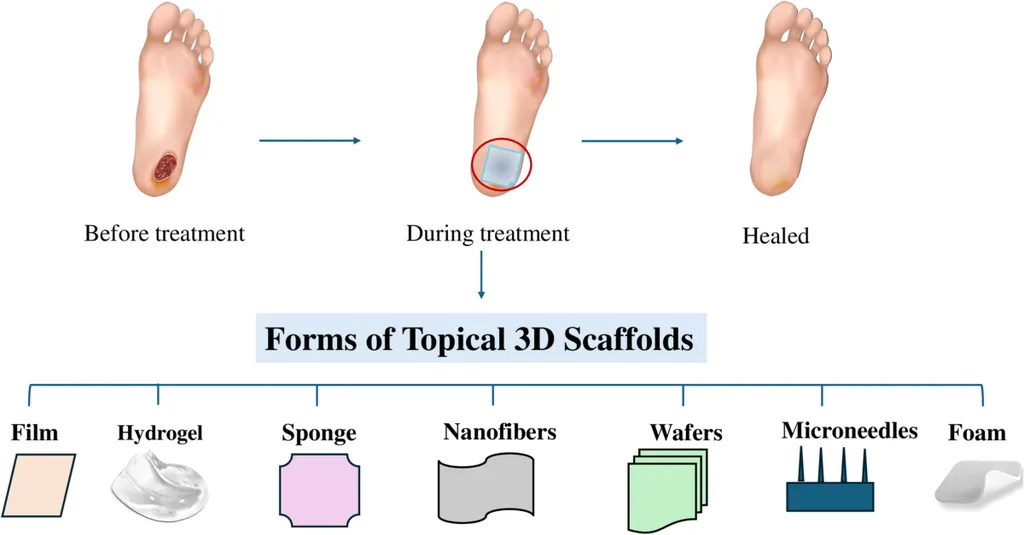In the relentless pursuit of effective treatments for diabetic wounds, a team of researchers led by Ziyi Han from Zhejiang University’s Department of Tea Science has made a significant breakthrough. Their innovative approach combines the power of natural compounds and advanced nanotechnology to accelerate wound healing, offering new hope for millions of people worldwide.
Diabetic wounds are a common and serious complication of diabetes, often leading to prolonged healing times and increased risk of infection. Traditional treatments have shown limited success, driving the need for novel therapeutic strategies. Han and his team have developed a ternary nanocomposite system that shows remarkable promise in addressing this critical clinical challenge.
The researchers first chelated epigallocatechin gallate (EGCG), a potent antioxidant found in green tea, with zinc ions (Zn2+) to form a complex. This complex was then incorporated into quaternized chitosan (QCS), a derivative of chitosan, a natural biopolymer known for its excellent biocompatibility and biodegradability. The resulting EGCG-Zn-QCS nanoparticles demonstrated exceptional stability and dispersibility, with a sustained release of EGCG.
In vitro studies revealed that the nanoparticles exhibited strong antioxidant and anti-inflammatory properties, effectively scavenging free radicals and reducing the secretion of pro-inflammatory cytokines in macrophages. They also showed potent antibacterial activity against Staphylococcus aureus, a common pathogen in diabetic wounds, and inhibited biofilm formation.
The true test of the nanoparticles’ efficacy came in vivo, where they were applied to full-thickness wounds in diabetic mice. The results were impressive. The EGCG-Zn-QCS nanoparticles significantly enhanced wound healing compared to EGCG or EGCG-Zn alone. They promoted macrophage polarization from the pro-inflammatory M1 phenotype to the anti-inflammatory M2 phenotype, reduced pro-inflammatory cytokines, and increased anti-inflammatory interleukin-10 (IL-10). The nanoparticles also enhanced superoxide dismutase (SOD) activity, a key antioxidant enzyme, and reduced malondialdehyde (MDA) levels, a marker of oxidative stress.
Moreover, the nanoparticles upregulated several growth factors and proteins involved in tissue repair and angiogenesis, such as transforming growth factor-beta (TGF-β), vascular endothelial growth factor (VEGF), epidermal growth factor (EGF), hypoxia-inducible factor-alpha (HIF-α), alpha-smooth muscle actin (α-SMA), and cluster of differentiation 31 (CD31). This led to increased cell proliferation and the formation of new blood vessels, further promoting wound healing.
“Our findings suggest that EGCG-Zn-QCS nanoparticles could be a promising strategy for diabetic wound healing,” said Han. “They offer a multifaceted approach, combining antioxidant, anti-inflammatory, and antibacterial properties with the ability to promote tissue repair and angiogenesis.”
The nanoparticles also showed excellent biocompatibility and safety. They caused no hemolysis or toxicity, and serum markers such as aspartate and alanine aminotransferases, urea, and creatinine remained within normal ranges. No organ pathology was observed, indicating that the nanoparticles are well-tolerated and safe for use.
This research, published in the journal Materials Today Advances (translated as “Advanced Materials Today”), opens up new avenues for the development of advanced wound healing therapies. The commercial potential is substantial, with applications not only in the treatment of diabetic wounds but also in other chronic wounds and tissue repair scenarios.
As the global prevalence of diabetes continues to rise, the need for effective wound care solutions becomes increasingly urgent. The EGCG-Zn-QCS nanoparticles developed by Han and his team represent a significant step forward in addressing this critical healthcare challenge. Their work not only advances our understanding of wound healing but also paves the way for the development of innovative, multifunctional therapies that can improve patient outcomes and quality of life.
In the words of Han, “This is just the beginning. We are excited about the potential of our nanoparticles and the possibilities they offer for the future of wound care.” As research continues, we can expect to see further developments in this field, bringing hope to millions of people living with diabetes and other chronic conditions.

